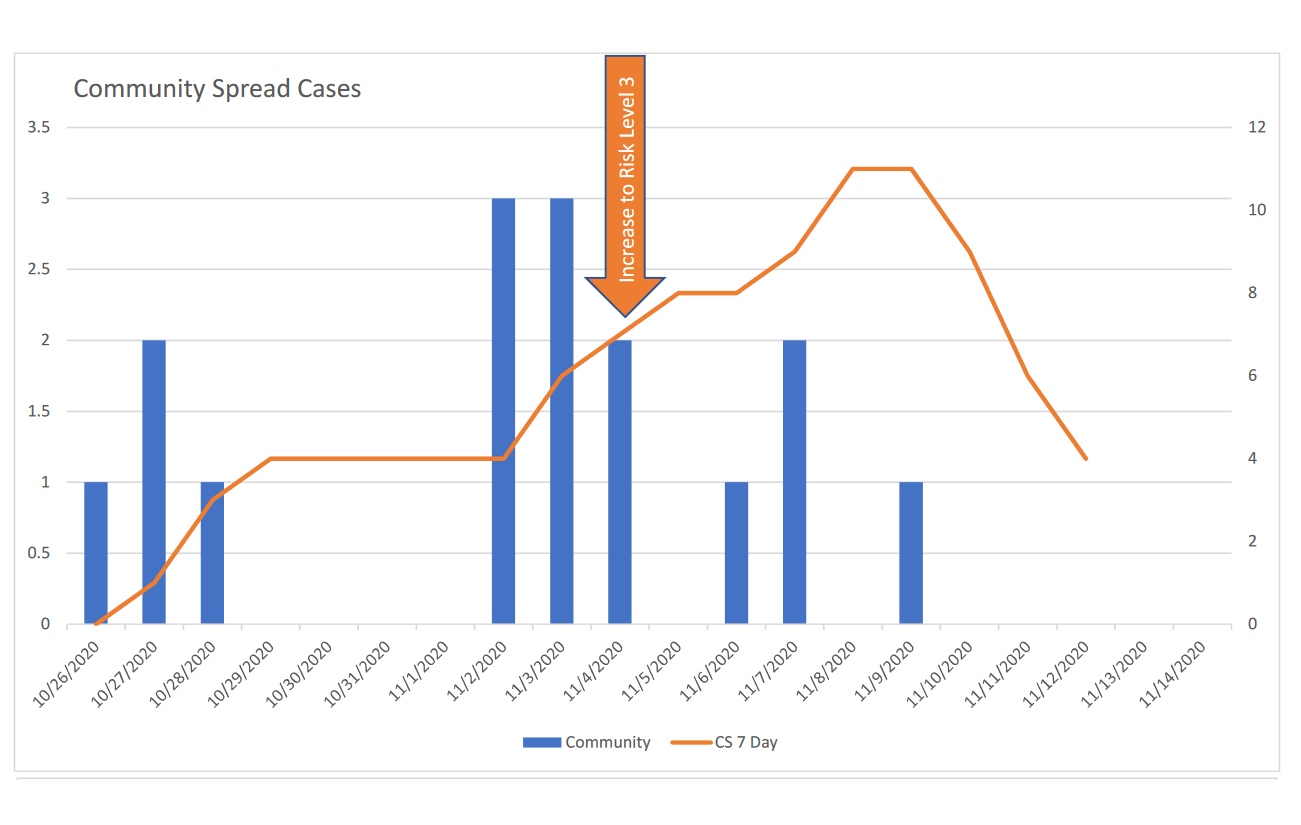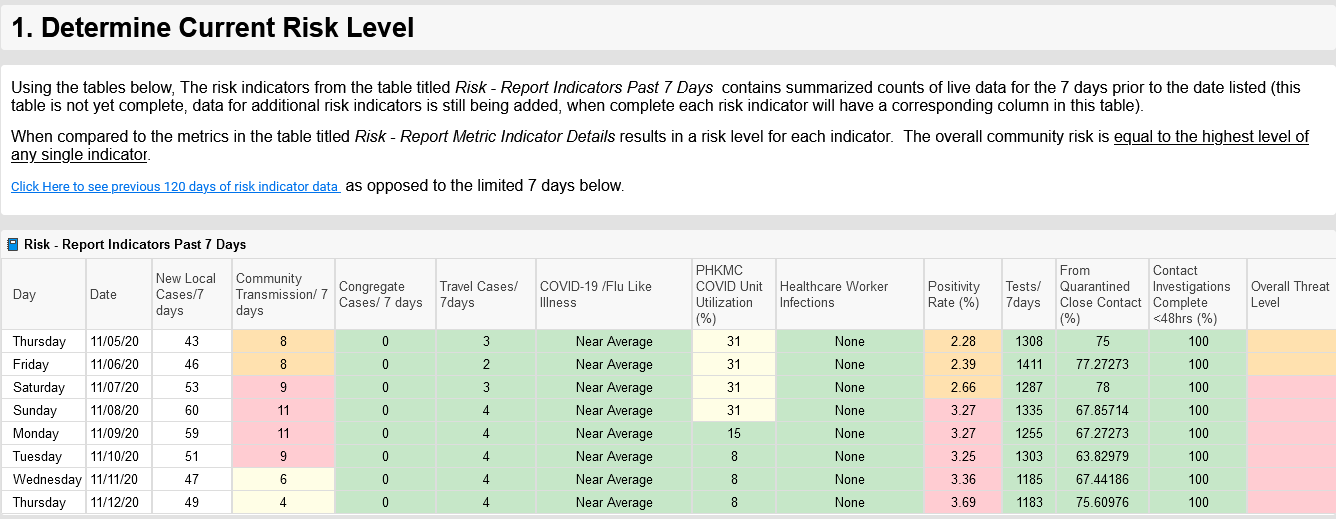
Officials say Ketchikan’s outbreak of COVID-19 that started in late October has slowed since the community risk level was raised on Nov. 4 (Ketchikan Emergency Operations Center graphic)
Ketchikan likely won’t see big changes to local pandemic restrictions in the near future. That’s despite a call from the governor on Thursday to “do everything possible” to reduce the spread of COVID-19 — namely, working from home and taking advantage of curbside service whenever feasible.
Local emergency officials say the governor’s recommendations mirror the message they’ve been sending for more than a week. Abner Hoage is leading Ketchikan’s local pandemic response.
“When you listen to the items that the governor is recommending and asking residents to comply with, to help with, those are the same — basically the same things that we’ve been asking,” Hoage said in a phone interview Thursday afternoon.
Ketchikan’s community risk level will stay at “high” for now — that’s where it’s been since Nov. 4. That means a mix of in-person and distance learning for most middle- and high-schoolers, but few mandatory restrictions on daily life in Ketchikan. Bars are encouraged, but not required, to close. Restaurants are urged, but again not required, to reduce capacity by half.
There’s one change to the local recommendations: any businesses or organizations able to work remotely are “urged” to send employees home as soon as possible. But that’s not a big difference from what local officials were already saying — previously, they “strongly recommend[ed]” teleworking “to the maximum extent possible.”
Officials announced Thursday evening that three Ketchikan borough facilities would close to the public Friday: the Gateway Recreation Center, the Pat Wise Animal Shelter and the White Cliff building, which houses many borough offices.
Notably, Hoage said Ketchikan teachers are not being asked to work from home. For now, most will continue to teach classes in person.
“The school impacts a lot of things in our community, and our school district has done a really good job putting their plan together. It’s been working for us, so we are not suggesting the school should change that plan,” Hoage said.
COVID-19 is spreading rapidly in Alaska. The state hasn’t seen a day with fewer than 300 cases reported since late last month. On Thursday morning, Dunleavy issued a statewide cell phone alert asking residents to, in his words, “do everything possible to reduce these cases and bend this trend downward.”
Here in Ketchikan, though, Hoage said there’s reason for optimism as the rate of spread appears to be falling.
“We are seeing most all of our indicators trending down,” Hoage said.

Local officials point to declining community spread as a reason for optimism. (Ketchikan Emergency Operations Center graphic)
He said there hasn’t been a confirmed case of community spread since Monday. There were four in the past seven days. That’s down from a weekly rate of 11 as of this weekend. The number of hospitalized patients has fallen from four to one. People infected at the start of this most recent outbreak late last month are starting to recover.
And, importantly, a majority of the cases since a new outbreak began on Oct. 26 have been traceable. As of Wednesday, two thirds of all new cases over the last seven days were already in quarantine — meaning they weren’t out spreading COVID-19 when they found out they were positive.

Click to enlarge. A matrix helps Ketchikan officials determine the community risk level – but according to Thursday’s statement, local mayors and managers must concur with pandemic response officials before the risk level is actually raised. The region’s positivity rate remains above a 3% threshold as of Thursday. (Ketchikan Emergency Operations Center)
While the local positivity rate remains relatively flat above a 3% threshold — corresponding to “very high” risk, or Level 4 — Hoage said the rate lags slightly behind reality and other metrics, since it draws on the previous 14-days of testing. Most of Ketchikan’s other pandemic indicators draw on a one-week average.
“It is a lagging indicator by a little bit, and so we’re seeing the trend back down,” Hoage said.
Hoage said that together, those indicators give him hope Ketchikan’s outbreak is waning. Contact tracing and testing are paying off, and sending some students home and encouraging businesses to close, reduce capacity or go remote seems to be working.
“I’m cautiously optimistic that we’re on the other side of it. That doesn’t mean we should let up today. We should continue to do those things that have been working for the past week. We know that the incubation period is one to two weeks, so we need to keep this up for probably another week,” Hoage said.
In other COVID-19 news on Prince of Wales Island, the city of Craig announced Thursday it would close public facilities to most in-person services for three weeks starting Friday. Services will be available by phone or with an appointment, and masks will be required when meeting with city staff.
And elsewhere in KRBD’s listening area, Metlakatla officials announced a third case of COVID-19 on Annette Island late Tuesday night. Metlakatla Indian Community said via social media that the local clinic, the Annette Island Service Unit, will soon begin to offer a COVID-19 test to anyone who’d like one. Metlakatla officials did not specify when that program would begin.
This story has been updated





